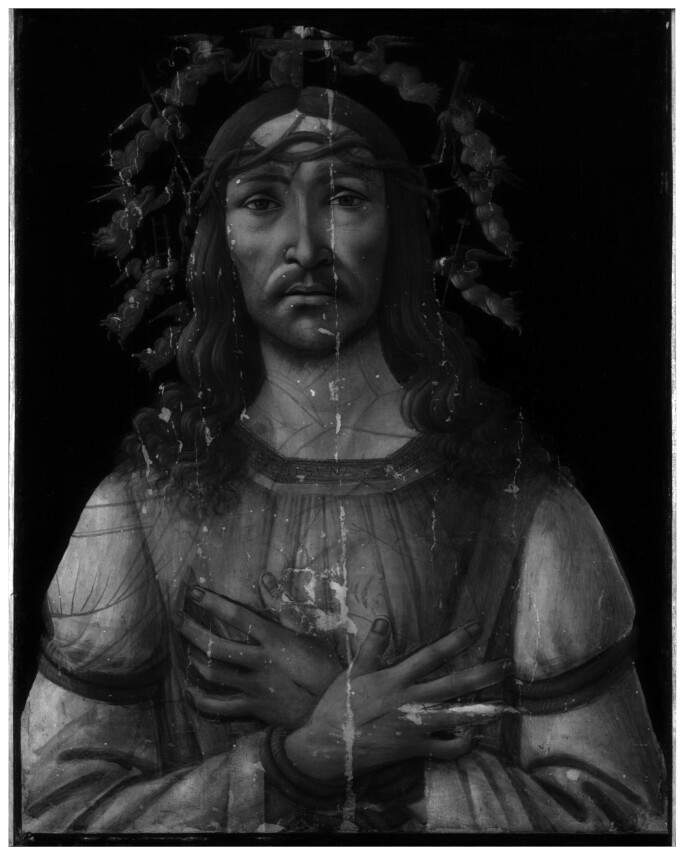It will go on auction next January 27 at Sotheby’s, in what we imagine will be the sale of the year, Sandro Botticelli’s Vir Dolorum, exactly one year after the record sale of $92.2 million for the Portrait of a Young Man with Medallion that was hammered out exactly one year ago. A work that everyone is now talking about, and which provided an additional surprise just before the sale: technical analysis revealed a drawing that Botticelli had erased, the profile of a Madonna, which was discovered thanks to infrared analysis.
The painting is in good condition, a situation that facilitated the attribution of the painting to Botticelli. It is a work referring to his late maturity, but all the typical elements of his painting appear in it: analyses in particular have remarked the modeling of the flesh tones, rendered with delicate brushstrokes of brown and pink on muted tones, and then engravings were found on the pictorial surface that define the cross above Jesus’ head (that of engravings was a typical practice of Botticelli and many other artists, who by engraving the surface obtained guides to trace some elements of the composition). Most importantly, technical analysis revealed, as anticipated, a drawing that the artist had erased.

Thanks to reflectography, it was possible to uncover a partial drawing unrelated to the Vir Dolorum, a Madonna and Child, which therefore makes it possible to state with certainty that the panel was originally prepared for a completely different image. In order to see them, one must rotate the image: analysis has revealed the outlines of what appear to be a Madonna and Child Jesus in the early stages of elaboration. The two figures appear close to the upper edge of the composition and are in a very close position, with their cheeks touching, in an iconography that, Sotheby’s notes in the painting’s file, derives from the image of the Virgin Eleousa common in Greek tradition and adapted by many Italian Renaissance painters. The Child’s head is shown looking upward, is held by the Madonna’s left hand, and the thick folds of her Virgin’s cloak are also visible. The Madonna was later replaced with the Vir Dolorum.
The investigation has thus provided a clearer idea of the process that led to the creation of this work. As for the Vir Dolorum, traces of numerous modifications made by Botticelli during the elaboration of the composition have been found. Adjustments are visible, for example, in the position of some thorns on Jesus’ temple, a change in the position of Christ’s eyebrows, a slight shift in the profile of his chin, and a lowering of Christ’s wound at the side. The marked changes observed in Christ’s hands further emphasize, according to experts, Botticelli’s authorship: the reference in particular is to the refined contours of the fingers and their placement in space. In addition to the notable shift in the foreshortening of Christ’s left thumb, his middle finger on that same hand was originally conceived as visible outside the open wound, an idea Botticelli eventually changed in the final drafting of the painting.


Where did the painting come from? The earliest records of Vir Dolorum date back to the nineteenth century. At the time, the work was part of the collection of the British politician Edward John Sartoris (1814-1888) and his wife Adelaide Kemble Sartoris (1815-1879), a famous opera singer and niece of the famous actress Sarah Siddons and John Philip Kemble. The work passed from hand to hand among heirs until it came to Adelaide’s great-granddaughter Pamela Margaret Stanley, who sold the painting in 1963 (also then in a sta at Sotheby’s), when it was purchased by the current owner.
Adelaide and Edward Sartoris were well-connected in the British society of the time and were regulars in the intellectual and artistic circles of the places where they lived and stayed, particularly Rome, Paris, and London (Adelaide, in particular, befriended Frederic Leighton, one of the leading English painters of the late 19th century). We do not know, however, how they came into possession of the Vir Dolorum: the Sartoris had a rich collection of Italian Old Masters, including a Gentile da Fabriano now in the National Gallery of Art in Washington as part of the Samuel H. Kress Collection. However, if we do not know the painting’s past, we do know what will happen after the sale: the painting has in fact been requested for the exhibition Botticelli and Renaissance Florence: Masterworks from the Uffizi, which will be held at the Minneapolis Institute of Art from October 15, 2022 to January 8, 2023. If it is loaned, the American public will have an important opportunity to see the work in person.
 |
| Botticelli, discovered drawing of a Madonna under the Vir Dolorum that will go to auction |
Warning: the translation into English of the original Italian article was created using automatic tools. We undertake to review all articles, but we do not guarantee the total absence of inaccuracies in the translation due to the program. You can find the original by clicking on the ITA button. If you find any mistake,please contact us.